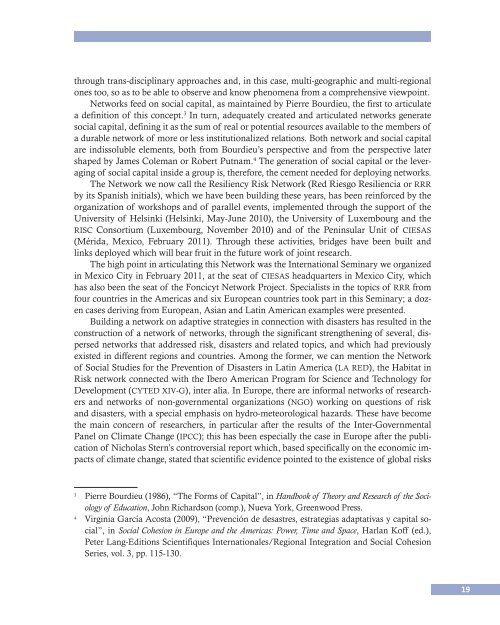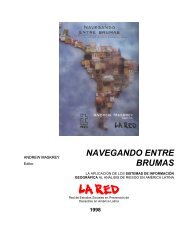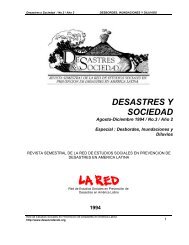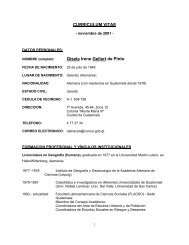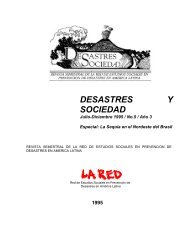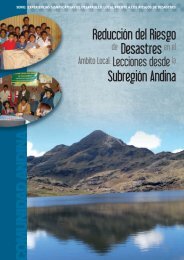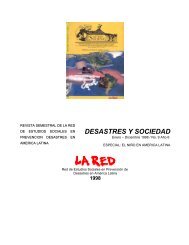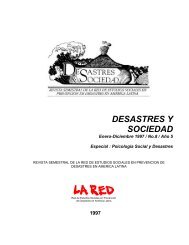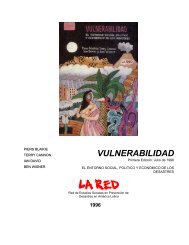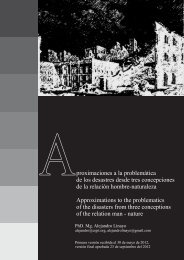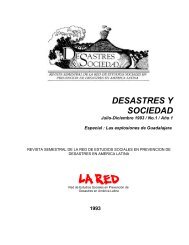Estrategias sociales de prevención y adaptación Social ... - La RED
Estrategias sociales de prevención y adaptación Social ... - La RED
Estrategias sociales de prevención y adaptación Social ... - La RED
Create successful ePaper yourself
Turn your PDF publications into a flip-book with our unique Google optimized e-Paper software.
through trans-disciplinary approaches and, in this case, multi-geographic and multi-regional<br />
ones too, so as to be able to observe and know phenomena from a comprehensive viewpoint.<br />
Networks feed on social capital, as maintained by Pierre Bourdieu, the first to articulate<br />
a <strong>de</strong>finition of this concept. 3 In turn, a<strong>de</strong>quately created and articulated networks generate<br />
social capital, <strong>de</strong>fining it as the sum of real or potential resources available to the members of<br />
a durable network of more or less institutionalized relations. Both network and social capital<br />
are indissoluble elements, both from Bourdieu’s perspective and from the perspective later<br />
shaped by James Coleman or Robert Putnam. 4 The generation of social capital or the leveraging<br />
of social capital insi<strong>de</strong> a group is, therefore, the cement nee<strong>de</strong>d for <strong>de</strong>ploying networks.<br />
The Network we now call the Resiliency Risk Network (Red Riesgo Resiliencia or rrr<br />
by its Spanish initials), which we have been building these years, has been reinforced by the<br />
organization of workshops and of parallel events, implemented through the support of the<br />
University of Helsinki (Helsinki, May-June 2010), the University of Luxembourg and the<br />
risc Consortium (Luxembourg, November 2010) and of the Peninsular Unit of ciesas<br />
(Mérida, Mexico, February 2011). Through these activities, bridges have been built and<br />
links <strong>de</strong>ployed which will bear fruit in the future work of joint research.<br />
The high point in articulating this Network was the International Seminary we organized<br />
in Mexico City in February 2011, at the seat of ciesas headquarters in Mexico City, which<br />
has also been the seat of the Foncicyt Network Project. Specialists in the topics of rrr from<br />
four countries in the Americas and six European countries took part in this Seminary; a dozen<br />
cases <strong>de</strong>riving from European, Asian and <strong>La</strong>tin American examples were presented.<br />
Building a network on adaptive strategies in connection with disasters has resulted in the<br />
construction of a network of networks, through the significant strengthening of several, dispersed<br />
networks that addressed risk, disasters and related topics, and which had previously<br />
existed in different regions and countries. Among the former, we can mention the Network<br />
of <strong>Social</strong> Studies for the Prevention of Disasters in <strong>La</strong>tin America (la red), the Habitat in<br />
Risk network connected with the Ibero American Program for Science and Technology for<br />
Development (cyted xiv-g), inter alia. In Europe, there are informal networks of researchers<br />
and networks of non-governmental organizations (ngo) working on questions of risk<br />
and disasters, with a special emphasis on hydro-meteorological hazards. These have become<br />
the main concern of researchers, in particular after the results of the Inter-Governmental<br />
Panel on Climate Change (ipcc); this has been especially the case in Europe after the publication<br />
of Nicholas Stern’s controversial report which, based specifically on the economic impacts<br />
of climate change, stated that scientific evi<strong>de</strong>nce pointed to the existence of global risks<br />
3<br />
Pierre Bourdieu (1986), “The Forms of Capital”, in Handbook of Theory and Research of the Soci<br />
ology of Education, John Richardson (comp.), Nueva York, Greenwood Press.<br />
4<br />
Virginia García Acosta (2009), “Prevención <strong>de</strong> <strong>de</strong>sastres, estrategias adaptativas y capital social”,<br />
in <strong>Social</strong> Cohesion in Europe and the Americas: Power, Time and Space, Harlan Koff (ed.),<br />
Peter <strong>La</strong>ng-Editions Scientifiques Internationales/Regional Integration and <strong>Social</strong> Cohesion<br />
Series, vol. 3, pp. 115-130.<br />
19


